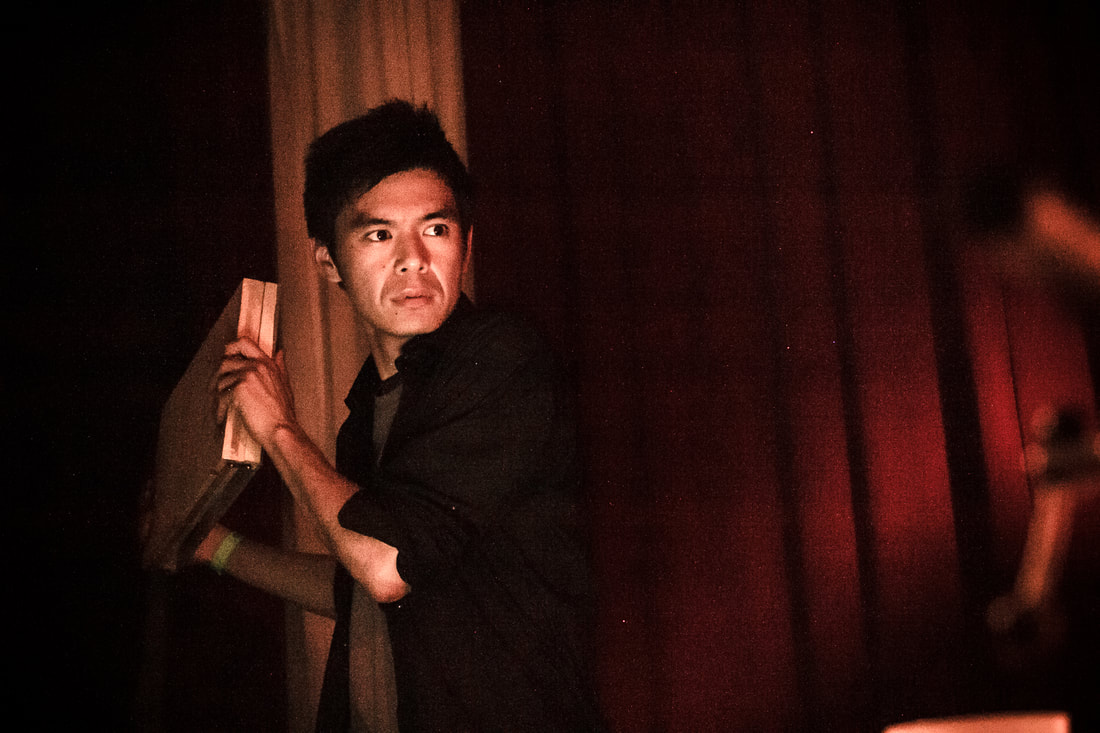|
photo courtesy of Mariya Donska
I first witnessed Takuto Fukuda perform one of his own pieces at the Montreal Conservatory of Music. He and his duo partner, Ana Dall’Ara Majek, took to the stage - Ana behind an augmented theremin and Fukuda grasping a wooden box. Fukuda began shaking the box (which I later found out was connected remotely to a laptop running Max), causing a series of tactile noises to emit from the venue’s PA and with each shake, gyration, and shimmy, new and ever-more inventive sounds popped out of the speakers. The piece not only explored a world of experimental electronic music that doesn’t often rear its head in North America, it employed humor and touches of fun to make the entire choreographed performance extremely fun to watch. “I think humour is a flip side of things taken for granted,” Fukuda said. “Sometimes new technologies open up new possibilities that reveal how naturally my view is prejudiced through my (lack of) experiences, knowledge, imagination about alternatives.” As an active composer-performer in Montreal, Fukuda explores the humorous and fun side of art music that many musicians typically brush aside. This study of the untouched and unknown also drives him to perform many of his own pieces. “There are two reasons why I still continue to perform by myself,” Fukuda said. “First, when I compose a piece for digital musical instruments, there are usually almost no skilled performers, as the performance practice for the instruments are not implemented in educational programs and the instruments are not proliferated enough to foster a pool of players in the world… Second, I find an advantage of self-performance - that is, to run on a rapid feedback among prototyping, performing and composing. Unlike traditional instruments, new digital interfaces are often less expected for a specific manner of performance as their histories do not yet nearly exit. This enables me to explore my own performance modes and even to modify the features of the instrument according to the need for performance and compositions.” Fukuda’s decision to perform and compose stemmed from his upbringing as a computer musician, and ultimately helped him find a new artistic home in Montreal. “[When] I started my [bachelors degree] at the college, I did not have efficient means to produce even sound,” Fukuda said. “Because I started to study music only as late as I was 19 years old, that is so late to master a foundation of music-making, such as solfeggi and playing an acoustic instrument. So, computer was for me the first practical tool to produce sound to me.” “During my [masters degree] in Graz, Austria, my friends, Jonathan Carter and Nick Acorne, suggested to perform as a laptop trio,” Fukuda continued. “After the first year of our experiment with commercial MIDI controllers, Nick Acorne suggested [that we] build our own gestural controllers using sensors… We built three DIY-style DMIs and created [a] number of repertoire with those instruments for self-performances. It had become our norm to perform with those controllers.“ “After I left Graz, and arrived in Montreal in Canada for my doctoral study in 2017, I reunited with a composer-performer, Ana Dall’Ara-Majek. It was the timing that she was wondering to perform more often with her own theremin, while I was looking for a collaborator to perform with my gestural controller. So, we started to create pieces together.” From these collaborations, Fukuda has brought electronic music to life like very few others and has found ways to make what might be run-of-the-mill performances into full-scale spectacles. His next major piece will push the boundary even further. “I am currently working on an audiovisual composition, “Simulacra,” for five cellists and computer,” Takuto said. “In this piece, I address the question: what is it that engenders a sense of ‘authentic’ concert experience in the age of simulation?” “The title refers to Jean Baudrillard's concept of ‘simulacrum’ defined as a copy without original. With this concept, he pointed out that the modern industrial world entered the situation where abstract models, symbols and codes generate numerous mass-produced items, thereby eliminating the concept of the original object existing in the physical world and so negating the concept of authenticity... Using various techniques for spatiotemporal dispositions… I aim to draw listeners attention to the ambiguity of the coupling of cause-effect relationship between performer’s gesture and resultant sounds.” Fukuda’s musical trajectory sets him apart from his peers and his approach to music finds the perfect balance between theory and showmanship that few composers can truly master. His art stands as a fantastic example of finding exciting ways to harness the unheard, while relating back to the everyday listener. “I want music to be a platform for intellectual exchanges among audience members, performers, composers and whoever committed to its production and reception, rather than seeing music as a single directional medium from a composer to the audience,” Fukuda said. “So, it would be great if my contribution will create a space into which other people can insert some commentaries in various forms such as literature, dance and other piece of music. I wish that we will be able to generate and share a plentiful number of ideas, insights, sentiments and dreams.” You can learn more about Fukuda on his website and Soundcloud.
1 Comment
Lily Koslow
5/1/2020 09:02:41 am
Awesome article! I got to see Takuto and Ana do an incredible gesture-based performance in the McGill MMR, and I definitely appreciated the kind of cosmic humor in it. So good!
Reply
Leave a Reply. |
AuthorErich is a musician and writer living between Montreal and New York whose work appears on Best Life, Eat This, Not That!, MSN, and more and has represented artists for years as a PR rep. He likes weird music. If you want to find his music, it's over here. Archives
August 2020
Categories |

